同济大学:《工程材料》课程电子教案(课件讲稿)Chapter 5 Material Physical Properties
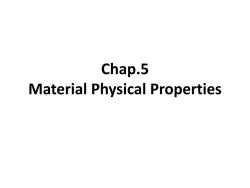
Chap.5 Material Physical Properties
Chap.5 Material Physical Properties
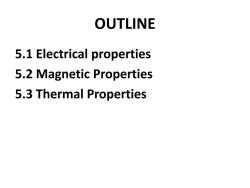
OUTLINE 5.1 Electrical properties 5.2 Magnetic Properties 5.3 Thermal Properties
OUTLINE 5.1 Electrical properties 5.2 Magnetic Properties 5.3 Thermal Properties

5.1 Electrical properties Why study the Electrical Properties of Materials? During the design of a component or structure, when we select material and make processing decisions,it's important to consider the electrical properties of materials.The electrical behaviors of different materials are diverse. Some need to be highly electrical conductive, while others need to be dielectrical
5.1 Electrical properties Why study the Electrical Properties of Materials? During the design of a component or structure, when we select material and make processing decisions, it’s important to consider the electrical properties of materials. The electrical behaviors of different materials are diverse. Some need to be highly electrical conductive, while others need to be dielectrical
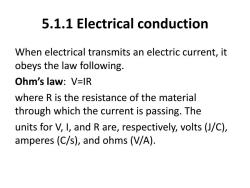
5.1.1 Electrical conduction When electrical transmits an electric current,it obeys the law following. Ohm's law:V=IR where R is the resistance of the material through which the current is passing.The units for V,l,and R are,respectively,volts (J/C), amperes(C/s),and ohms(V/A)
5.1.1 Electrical conduction When electrical transmits an electric current, it obeys the law following. Ohm’s law: V=IR where R is the resistance of the material through which the current is passing. The units for V, I, and R are, respectively, volts (J/C), amperes (C/s), and ohms (V/A)
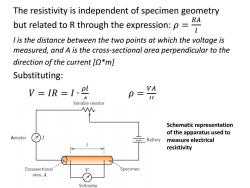
The resistivity is independent of specimen geometry but related to R through the expression:p= RA I is the distance between the two points at which the voltage is measured,and A is the cross-sectional area perpendicular to the direction of the current [Q*m] Substituting: V=IR=1. VA Variable resistor Schematic representation of the apparatus used to Ameter Battery measure electrical resistivity Crosssectional Specimen area,A Voltmeter
The resistivity is independent of specimen geometry but related to R through the expression: 𝜌 = 𝑅𝐴 𝑙 l is the distance between the two points at which the voltage is measured, and A is the cross-sectional area perpendicular to the direction of the current [Ω*m] Substituting: 𝑉 = 𝐼𝑅 = 𝐼 ∙ 𝜌𝑙 𝐴 𝜌 = 𝑉𝐴 𝐼𝑙 Schematic representation of the apparatus used to measure electrical resistivity
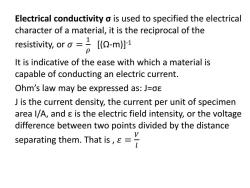
Electrical conductivity o is used to specified the electrical character of a material,it is the reciprocal of the resistivity,or[(m) It is indicative of the ease with which a material is capable of conducting an electric current. Ohm's law may be expressed as:J=o8 J is the current density,the current per unit of specimen area l/A,and is the electric field intensity,or the voltage difference between two points divided by the distance separating them.That is,=7
Electrical conductivity σ is used to specified the electrical character of a material, it is the reciprocal of the resistivity, or 𝜎 = 1 𝜌 [(Ω-m)]-1 It is indicative of the ease with which a material is capable of conducting an electric current. Ohm’s law may be expressed as: J=σε J is the current density, the current per unit of specimen area I/A, and ε is the electric field intensity, or the voltage difference between two points divided by the distance separating them. That is , 𝜀 = 𝑉 𝑙
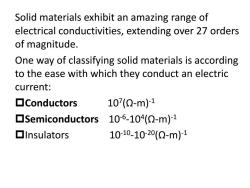
Solid materials exhibit an amazing range of electrical conductivities,extending over 27 orders of magnitude. One way of classifying solid materials is according to the ease with which they conduct an electric current: ▣Conductors 107(0-m)-1 ▣Semiconductors 10-6-104(2-m)-1 ▣Insulators 10-10-10-20(2-m)-1
Solid materials exhibit an amazing range of electrical conductivities, extending over 27 orders of magnitude. One way of classifying solid materials is according to the ease with which they conduct an electric current: Conductors 107 (Ω-m)-1 Semiconductors 10-6 -104 (Ω-m)-1 Insulators 10-10 -10-20(Ω-m) -1
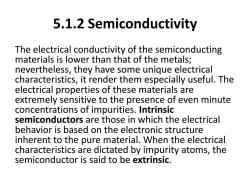
5.1.2 Semiconductivity The electrical conductivity of the semiconducting materials is lower than that of the metals; nevertheless,they have some unique electrical characteristics,it render them especially useful.The electrical properties of these materials are extremely sensitive to the presence of even minute concentrations of impurities.Intrinsic semiconductors are those in which the electrical behavior is based on the electronic structure inherent to the pure material.When the electrical characteristics are dictated by impurity atoms,the semiconductor is said to be extrinsic
5.1.2 Semiconductivity The electrical conductivity of the semiconducting materials is lower than that of the metals; nevertheless, they have some unique electrical characteristics, it render them especially useful. The electrical properties of these materials are extremely sensitive to the presence of even minute concentrations of impurities. Intrinsic semiconductors are those in which the electrical behavior is based on the electronic structure inherent to the pure material. When the electrical characteristics are dictated by impurity atoms, the semiconductor is said to be extrinsic
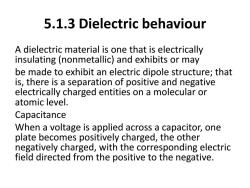
5.1.3 Dielectric behaviour A dielectric material is one that is electrically insulating (nonmetallic)and exhibits or may be made to exhibit an electric dipole structure;that is,there is a separation of positive and negative electrically charged entities on a molecular or atomic level. Capacitance When a voltage is applied across a capacitor,one plate becomes positively charged,the other negatively charged,with the corresponding electric field directed from the positive to the negative
5.1.3 Dielectric behaviour A dielectric material is one that is electrically insulating (nonmetallic) and exhibits or may be made to exhibit an electric dipole structure; that is, there is a separation of positive and negative electrically charged entities on a molecular or atomic level. Capacitance When a voltage is applied across a capacitor, one plate becomes positively charged, the other negatively charged, with the corresponding electric field directed from the positive to the negative
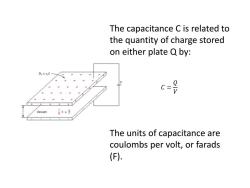
The capacitance C is related to the quantity of charge stored on either plate Q by: D0= Q Vacuum ↓z=H The units of capacitance are coulombs per volt,or farads (F)
The capacitance C is related to the quantity of charge stored on either plate Q by: The units of capacitance are coulombs per volt, or farads (F). 𝐶 = 𝑄 𝑉
按次数下载不扣除下载券;
注册用户24小时内重复下载只扣除一次;
顺序:VIP每日次数-->可用次数-->下载券;
- 同济大学:《工程材料》课程电子教案(课件讲稿)Chapter 4 材料特性 Material properties.pdf
- 同济大学:《工程材料》课程电子教案(课件讲稿)Chapter 3 Defect in Crystals.pdf
- 同济大学:《工程材料》课程电子教案(课件讲稿)Chapter 2 Material and Structure.pdf
- 同济大学:《工程材料》课程电子教案(课件讲稿)Chapter 1 Introduction to Engineering Material(负责人:杨玉娟).pdf
- 同济大学:《工程热力学》课程电子教案(讲稿)Chapter 12 Ideal Gas Mixture and Psychrometric Applications.pdf
- 同济大学:《工程热力学》课程电子教案(讲稿)Chapter 10 Refrigeration and Heat Pump Systems.pdf
- 同济大学:《工程热力学》课程电子教案(讲稿)Chapter 9 Gas Power Systems.pdf
- 同济大学:《工程热力学》课程电子教案(讲稿)Chapter 8 Vapor Power Systems.pdf
- 同济大学:《工程热力学》课程电子教案(讲稿)Chapter 6 Using Entropy.pdf
- 同济大学:《工程热力学》课程电子教案(讲稿)Chapter 5 The Second Law of Thermodynamics.pdf
- 同济大学:《工程热力学》课程电子教案(讲稿)Chapter 4 Control Volume Analysis.pdf
- 同济大学:《工程热力学》课程电子教案(讲稿)Chapter 3 Evaluating Properties.pdf
- 同济大学:《工程热力学》课程电子教案(讲稿)Chapter 2 Energy First Law of Thermodynamics.pdf
- 同济大学:《工程热力学》课程电子教案(讲稿)Chapter 1 Getting Started - Introductory Concepts and Definitions(负责人:高乃平).pdf
- 北京化工大学:《材料导论》课程教学资源(课件讲稿)Module9 Professional Paper Writing in English.pdf
- 北京化工大学:《材料导论》课程教学资源(课件讲稿)Module8 Presentation Skill.pdf
- 北京化工大学:《材料导论》课程教学资源(课件讲稿)Module7 Composites.pdf
- 北京化工大学:《材料导论》课程教学资源(课件讲稿)Module6 Ceramic Materials.pdf
- 北京化工大学:《材料导论》课程教学资源(课件讲稿)Module5 Polymeric Materials.pdf
- 北京化工大学:《材料导论》课程教学资源(课件讲稿)Module4 Metallic Materials.pdf
- 同济大学:《工程材料》课程电子教案(课件讲稿)Chapter 6 Phase diagrams.pdf
- 同济大学:《工程材料》课程电子教案(课件讲稿)Chapter 7 Fe-C Alloy.pdf
- 《纺织复合材料》课程参考文献(3-D textile reinforcements in composite materials)00 Introduction(Why are 3-D textile technologies applied to composite materials?).pdf
- 《纺织复合材料》课程参考文献(3-D textile reinforcements in composite materials)01 3-D textile reinforcements in composite materials.pdf
- 《纺织复合材料》课程参考文献(3-D textile reinforcements in composite materials)02 3-D textile reinforced composites for the transportation industry.pdf
- 《纺织复合材料》课程参考文献(3-D textile reinforcements in composite materials)03 Mechanical modelling of solid woven fabric composites.pdf
- 《纺织复合材料》课程参考文献(3-D textile reinforcements in composite materials)04 Macromechanical analysis of 3-D textile reinforced composites.pdf
- 《纺织复合材料》课程参考文献(3-D textile reinforcements in composite materials)05 Manufacture and design of composite grids.pdf
- 《纺织复合材料》课程参考文献(3-D textile reinforcements in composite materials)06 Knitted fabric composites.pdf
- 《纺织复合材料》课程参考文献(3-D textile reinforcements in composite materials)07 Braided structures.pdf
- 《纺织复合材料》课程参考文献(3-D textile reinforcements in composite materials)08 3-D forming of continuous fibre reinforcements for composites.pdf
- 《纺织复合材料》课程参考文献(3-D textile reinforcements in composite materials)09 Resin impregnation and prediction of fabric properties.pdf
- 《纺织复合材料》课程参考文献(3-D textile reinforcements in composite materials)Index.pdf
- 《纺织复合材料》课程参考文献(3-D textile reinforcements in composite materials)3-D textile reinforcements in composite materials.pdf
- 《纺织复合材料》课程教学资源(书籍文献)Microstructural Design of Fiber Composites.pdf
- 《纺织复合材料》课程参考文献(Composite materials design and applications)01 COMPOSITE MATERIALS, INTEREST, AND PROPERTIES.pdf
- 《纺织复合材料》课程参考文献(Composite materials design and applications)02 FABRICATION PROCESSES.pdf
- 《纺织复合材料》课程参考文献(Composite materials design and applications)03 PLY PROPERTIES.pdf
- 《纺织复合材料》课程参考文献(Composite materials design and applications)04 SANDWICH STRUCTURES.pdf
- 《纺织复合材料》课程参考文献(Composite materials design and applications)05 CONCEPTION AND DESIGN.pdf
